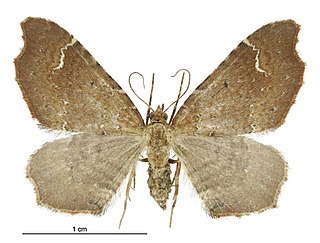Elkalyce kala, the black Cupid, is a small butterfly found in India that belongs to the lycaenids or blues family.

Parapoynx stratiotata, the ringed china-mark, is a moth of the family Crambidae. The species was first described by Carl Linnaeus in his 1758 10th edition of Systema Naturae. It is found in Europe where the distribution area extends in the north to the British Isles including Ireland and in the south to Sardinia, Sicily and Greece. The species is also found across the Palearctic in North Africa, Lebanon, Turkey, Azerbaijan, Kyrgyzstan, Uzbekistan and China..

Catochrysops strabo, the forget-me-not, is a small butterfly found in Asia that belongs to the lycaenids or blues family. The species was first described by Johan Christian Fabricius in 1793. It is found in Sri Lanka, India, from Sikkim to Indochina and in Sundaland, Sulawesi and the Philippines.
Antaeotricha pseudochyta is a species of moth of the family Depressariidae. It is found in Guyana and Grenada.
Eudonia perierga is a moth in the family Crambidae. It was described by Edward Meyrick in 1885. It is found in Australia, where it has been recorded from Tasmania.
Catacometes hemiscia is a moth in the family Oecophoridae. It was described by Edward Meyrick in 1883. It is found in Australia, where it has been recorded from New South Wales.
Ardozyga englypta is a species of moth in the family Gelechiidae. It was described by Edward Meyrick in 1904. It is found in Australia, where it has been recorded from Victoria.
Antaeotricha fulta is a moth of the family Depressariidae. It is found in Colombia.
Antaeotricha marmorea is a moth of the family Depressariidae. It is found in Brazil and Bolivia.
Antaeotricha episimbla is a moth of the family Depressariidae. It is found in Guyana.
Antaeotricha doleropis is a moth of the family Depressariidae. It is found in Guyana.
Antaeotricha erotica is a moth of the family Depressariidae. It is found in French Guiana.
Zaphanaula hemileuca is a moth in the family Xyloryctidae, and the only species in the genus Zaphanaula. It was described by Turner in 1896. It is found in Australia, where it has been recorded from Queensland.
Plectophila micradelpha is a moth in the family Xyloryctidae. It was described by Turner in 1898. It is found in Australia, where it has been recorded from Queensland.
Aeolanthes siphonias is a moth in the family Depressariidae. It was described by Edward Meyrick in 1908. It is found in northern India.
Eutorna eurygramma is a moth in the family Depressariidae. It was described by Edward Meyrick in 1906. It is found in Australia, where it has been recorded from Victoria, New South Wales and Tasmania.
Antaeotricha gubernatrix is a species of moth in the family Depressariidae. It was described by Edward Meyrick in 1925. It is found in Peru.
Antaeotricha plerotis is a species of moth in the family Depressariidae. It was described by Edward Meyrick in 1925. It is found in Peru.

Asaphodes camelias is a species of moth in the family Geometridae. It is endemic to New Zealand, has been observed in both the North and South Islands and inhabits native forest. The adults of this species are on the wing from February to May and July to September.

Proteodes melographa is a species of moth in the family Depressariidae. It is endemic to New Zealand and has been observed at Mount Arthur and in the Nelson District. It inhabits forest in the alpine zone. The larvae of this species feeds on native beech trees.



